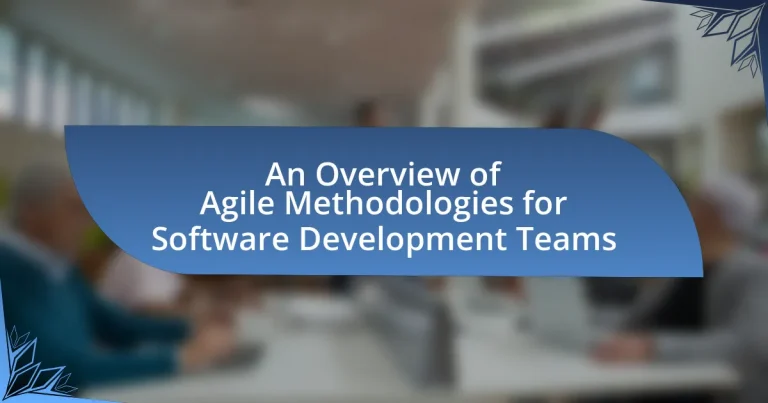Agile methodologies in software development are iterative and incremental approaches that prioritize flexibility, collaboration, and customer feedback. This article provides an overview of Agile methodologies, including key principles, differences from traditional approaches, and various frameworks such as Scrum and Kanban. It discusses the essential roles within Agile teams, the benefits of implementing Agile practices, and the challenges faced during adoption. Additionally, the article highlights best practices for effective Agile implementation, tools that support Agile project management, and strategies for customizing Agile frameworks to meet specific project needs.

What are Agile Methodologies in Software Development?
Agile methodologies in software development are iterative and incremental approaches that emphasize flexibility, collaboration, and customer feedback. These methodologies prioritize delivering small, functional pieces of software frequently, allowing teams to adapt to changing requirements and improve product quality through continuous testing and integration. The Agile Manifesto, created in 2001 by a group of software developers, outlines core values and principles that guide these methodologies, such as valuing individuals and interactions over processes and tools, and responding to change over following a plan. Agile practices, including Scrum and Kanban, have been widely adopted in the industry, leading to increased efficiency and better alignment with customer needs.
How do Agile Methodologies differ from traditional approaches?
Agile methodologies differ from traditional approaches primarily in their flexibility and iterative nature. Traditional approaches, often referred to as Waterfall, follow a linear and sequential process where each phase must be completed before the next begins, making it difficult to adapt to changes. In contrast, Agile methodologies emphasize collaboration, customer feedback, and rapid iterations, allowing teams to respond to changing requirements throughout the development process. This adaptability is supported by frameworks such as Scrum and Kanban, which facilitate continuous improvement and frequent reassessment of project goals. Agile’s focus on delivering small, functional increments of software enables teams to gather user feedback early and often, which is less feasible in traditional models that typically deliver a complete product only at the end of the project cycle.
What are the key principles of Agile Methodologies?
The key principles of Agile Methodologies include customer satisfaction, welcoming changing requirements, delivering working software frequently, collaboration between business and technical teams, motivated individuals, face-to-face conversation, working software as the primary measure of progress, sustainable development, technical excellence, simplicity, and self-organizing teams. These principles are outlined in the Agile Manifesto, which emphasizes flexibility, iterative progress, and responsiveness to change. The principles guide teams in creating adaptive and efficient workflows, ultimately enhancing product quality and customer engagement.
Why is flexibility important in Agile Methodologies?
Flexibility is crucial in Agile methodologies because it enables teams to adapt to changing requirements and market conditions effectively. Agile frameworks, such as Scrum and Kanban, emphasize iterative development and continuous feedback, allowing teams to pivot quickly based on stakeholder input or unforeseen challenges. This adaptability leads to improved product quality and customer satisfaction, as teams can incorporate changes without significant delays. Research by the Standish Group indicates that Agile projects are 28% more successful than traditional methodologies, highlighting the importance of flexibility in achieving project goals.
What are the main types of Agile Methodologies?
The main types of Agile methodologies include Scrum, Kanban, Extreme Programming (XP), Lean Software Development, and Feature-Driven Development (FDD). Scrum is characterized by its use of time-boxed iterations called sprints, where teams work collaboratively to deliver increments of a product. Kanban focuses on visualizing work in progress and optimizing flow, allowing teams to manage tasks efficiently. Extreme Programming emphasizes technical excellence and customer satisfaction through frequent releases and continuous feedback. Lean Software Development aims to eliminate waste and improve efficiency by focusing on value delivery. Feature-Driven Development organizes work around building features in a systematic manner. Each methodology has distinct practices and principles that cater to different project needs and team dynamics.
What is Scrum and how does it function?
Scrum is an Agile framework designed for managing complex projects, primarily in software development. It functions through iterative cycles called Sprints, typically lasting two to four weeks, during which a cross-functional team works to deliver a potentially shippable product increment. Scrum emphasizes collaboration, accountability, and continuous improvement, facilitated by defined roles such as the Scrum Master, who ensures adherence to the process, and the Product Owner, who prioritizes the product backlog. The framework includes key events like Sprint Planning, Daily Stand-ups, Sprint Reviews, and Sprint Retrospectives, which promote transparency and adaptation. According to the Scrum Guide, these practices help teams respond effectively to changing requirements and enhance productivity.
What is Kanban and what are its core practices?
Kanban is a visual workflow management method used to optimize and manage work in progress, primarily in software development and other industries. Its core practices include visualizing work through a Kanban board, limiting work in progress (WIP) to enhance focus and efficiency, managing flow to ensure smooth transitions between tasks, making process policies explicit to clarify expectations, and continuously improving processes through regular feedback and adaptation. These practices facilitate better communication, increased productivity, and a more responsive approach to changing project demands.
How does Extreme Programming (XP) enhance software quality?
Extreme Programming (XP) enhances software quality through practices such as continuous integration, test-driven development, and pair programming. These methodologies promote frequent feedback and collaboration, allowing teams to identify and resolve defects early in the development process. For instance, continuous integration ensures that code changes are automatically tested and integrated, reducing integration issues and improving overall code quality. Test-driven development mandates writing tests before code, which leads to better-designed, more reliable software. Additionally, pair programming fosters knowledge sharing and immediate code review, further elevating the quality of the final product.
What roles are essential in Agile Software Development Teams?
Essential roles in Agile Software Development Teams include the Scrum Master, Product Owner, and Development Team members. The Scrum Master facilitates the Agile process, ensuring that the team adheres to Agile principles and practices. The Product Owner is responsible for defining the product vision and prioritizing the backlog to maximize value. Development Team members are cross-functional professionals who design, develop, and test the product increment. These roles are critical for effective collaboration and delivery of high-quality software in Agile environments.
What responsibilities does a Scrum Master hold?
A Scrum Master is responsible for facilitating the Scrum process and ensuring that the Scrum team adheres to Agile principles. This includes coaching team members on Scrum practices, removing impediments that hinder the team’s progress, and fostering a collaborative environment. Additionally, the Scrum Master serves as a liaison between the team and stakeholders, ensuring clear communication and alignment on project goals. The effectiveness of a Scrum Master is supported by the Scrum Guide, which outlines these roles and responsibilities as essential for successful Agile implementation.
How does a Product Owner contribute to the Agile process?
A Product Owner contributes to the Agile process by defining and prioritizing the product backlog, ensuring that the development team focuses on delivering maximum value. This role involves gathering requirements from stakeholders, translating them into user stories, and maintaining a clear vision of the product. The Product Owner also collaborates closely with the development team during sprints, providing feedback and making decisions to adapt the product direction based on user feedback and market changes. This continuous engagement helps align the product development with customer needs and business goals, ultimately enhancing the effectiveness of the Agile process.
What is the significance of cross-functional teams in Agile?
Cross-functional teams in Agile are significant because they integrate diverse skills and expertise, enabling faster decision-making and enhanced collaboration. This structure allows team members from various disciplines, such as development, testing, and design, to work together seamlessly, which accelerates the delivery of high-quality software. Research indicates that organizations employing cross-functional teams experience a 30% increase in productivity and a 50% reduction in time-to-market, demonstrating the effectiveness of this approach in Agile methodologies.

What are the benefits of implementing Agile Methodologies?
Implementing Agile methodologies enhances project flexibility and responsiveness to change. Agile allows teams to adapt quickly to evolving requirements, which is crucial in dynamic environments. According to the 2021 State of Agile Report, 58% of organizations reported improved project visibility and 54% noted increased team productivity after adopting Agile practices. These methodologies promote continuous feedback and iterative development, leading to higher quality products and increased customer satisfaction.
How do Agile Methodologies improve team collaboration?
Agile methodologies improve team collaboration by promoting iterative communication and continuous feedback among team members. This approach fosters an environment where individuals can share ideas, address challenges, and adapt to changes quickly, enhancing overall teamwork. For instance, daily stand-up meetings and regular sprint reviews facilitate open dialogue, allowing teams to align their goals and adjust their strategies based on real-time insights. Research indicates that teams using Agile practices report a 25% increase in collaboration effectiveness, as measured by improved project outcomes and team satisfaction.
What tools facilitate communication in Agile teams?
Agile teams utilize various tools to facilitate communication, including Slack, Microsoft Teams, and Jira. Slack provides real-time messaging and channels for organized discussions, enhancing team collaboration. Microsoft Teams integrates chat, video conferencing, and file sharing, allowing seamless communication across remote teams. Jira, primarily a project management tool, also supports communication through task comments and updates, ensuring all team members are aligned on project progress. These tools are widely adopted in Agile environments due to their ability to streamline communication and improve team efficiency.
How does Agile foster a culture of continuous improvement?
Agile fosters a culture of continuous improvement by implementing iterative processes that encourage regular feedback and adaptation. This methodology emphasizes short development cycles, known as sprints, which allow teams to assess their work frequently and make necessary adjustments. For instance, the practice of conducting retrospectives at the end of each sprint enables teams to reflect on their performance, identify areas for enhancement, and implement actionable changes in subsequent iterations. Research by the Agile Alliance highlights that organizations adopting Agile report increased team collaboration and productivity, demonstrating the effectiveness of continuous improvement practices inherent in Agile methodologies.
What impact do Agile Methodologies have on project outcomes?
Agile methodologies significantly enhance project outcomes by promoting flexibility, collaboration, and iterative progress. These approaches enable teams to respond quickly to changes in requirements and customer feedback, resulting in higher customer satisfaction. According to the 2021 State of Agile Report, organizations that adopt Agile practices report a 60% improvement in project visibility and a 50% increase in team productivity. Furthermore, Agile methodologies facilitate continuous delivery of valuable software, which leads to reduced time-to-market and improved overall project success rates.
How does Agile enhance customer satisfaction?
Agile enhances customer satisfaction by promoting continuous feedback and iterative development, which ensures that the final product aligns closely with customer needs. This methodology allows teams to adapt to changing requirements and incorporate customer input throughout the development process, leading to a product that better meets user expectations. Research indicates that organizations using Agile report a 20-30% increase in customer satisfaction due to improved responsiveness and engagement, as highlighted in the “State of Agile” report by VersionOne.
What metrics can be used to measure success in Agile projects?
Agile projects can be measured for success using metrics such as velocity, sprint burndown, lead time, cycle time, and customer satisfaction. Velocity quantifies the amount of work completed in a sprint, providing insight into team productivity. Sprint burndown charts visualize the remaining work in a sprint, helping teams track progress and adjust efforts accordingly. Lead time measures the time taken from the initial request to delivery, while cycle time focuses on the duration from when work begins to when it is completed. Customer satisfaction is often gauged through surveys or Net Promoter Scores, reflecting the end-users’ perception of the product’s value. These metrics collectively offer a comprehensive view of an Agile project’s performance and areas for improvement.

What challenges do teams face when adopting Agile Methodologies?
Teams face several challenges when adopting Agile methodologies, including resistance to change, lack of experience, and insufficient stakeholder engagement. Resistance to change often stems from established organizational cultures that favor traditional project management approaches, making it difficult for teams to embrace Agile principles. Lack of experience with Agile practices can lead to improper implementation, resulting in confusion and inefficiencies. Additionally, insufficient stakeholder engagement can hinder collaboration and feedback, which are critical for Agile success. According to the 2021 State of Agile Report, 58% of respondents cited organizational culture as a significant barrier to Agile adoption, highlighting the importance of addressing these challenges for effective implementation.
What common misconceptions exist about Agile?
Common misconceptions about Agile include the belief that it is solely a project management methodology, that it eliminates the need for documentation, and that it guarantees faster delivery of products. Agile is not just a methodology; it is a mindset that emphasizes collaboration, flexibility, and customer feedback throughout the development process. While Agile promotes working software over comprehensive documentation, it does not advocate for the complete absence of documentation; rather, it encourages just enough documentation to support the project. Additionally, Agile does not inherently ensure faster delivery; it focuses on delivering value incrementally, which may lead to faster releases but depends on various factors such as team experience and project complexity.
How can teams overcome resistance to Agile adoption?
Teams can overcome resistance to Agile adoption by fostering a culture of open communication and continuous education. By engaging team members in discussions about Agile principles and practices, teams can address concerns and misconceptions directly. Research indicates that organizations that provide training and involve employees in the transition process experience a 70% higher success rate in Agile adoption (Source: “The State of Agile Report 2021,” VersionOne). Additionally, involving stakeholders in decision-making and demonstrating quick wins through pilot projects can build trust and showcase the benefits of Agile, further reducing resistance.
What are the pitfalls of misapplying Agile principles?
Misapplying Agile principles can lead to several significant pitfalls, including reduced team morale, ineffective communication, and failure to deliver value. When Agile practices are superficially adopted without understanding their core values, teams may experience confusion and frustration, as roles and responsibilities become unclear. For instance, if daily stand-ups are conducted merely as a formality rather than as a genuine opportunity for collaboration, team members may disengage, leading to decreased productivity. Additionally, neglecting the iterative nature of Agile can result in incomplete or poorly integrated features, ultimately failing to meet customer needs. Research indicates that organizations that do not fully embrace Agile methodologies often report lower project success rates, highlighting the importance of proper implementation.
How can teams effectively transition to Agile Methodologies?
Teams can effectively transition to Agile methodologies by adopting a structured approach that includes training, iterative implementation, and continuous feedback. First, providing comprehensive training on Agile principles and practices ensures that all team members understand the framework. Research indicates that organizations with formal Agile training report a 30% increase in project success rates. Next, teams should implement Agile in iterations, starting with a pilot project to identify challenges and refine processes. According to the 2021 State of Agile Report, 58% of organizations that began with pilot projects experienced smoother transitions. Finally, establishing regular feedback loops through retrospectives allows teams to adapt and improve continuously, fostering a culture of collaboration and responsiveness. This approach aligns with Agile’s core values and principles, ensuring a successful transition.
What steps should be taken for a successful Agile transformation?
To achieve a successful Agile transformation, organizations should follow these steps: first, assess the current organizational culture and readiness for change, ensuring alignment with Agile principles. Next, provide comprehensive training for all team members on Agile methodologies, such as Scrum or Kanban, to build a foundational understanding. Subsequently, establish cross-functional teams that encourage collaboration and communication, breaking down silos. Implement iterative processes, allowing for regular feedback and adjustments to improve workflows continuously. Finally, measure progress through key performance indicators (KPIs) to evaluate the effectiveness of the transformation and make necessary adjustments. These steps are supported by research indicating that organizations with a clear transformation strategy and ongoing support experience higher success rates in Agile adoption.
How can training and coaching support Agile adoption?
Training and coaching can significantly enhance Agile adoption by equipping teams with the necessary skills and mindset to implement Agile practices effectively. Through structured training programs, team members learn the principles and frameworks of Agile methodologies, such as Scrum and Kanban, which fosters a shared understanding and alignment on Agile values. Coaching provides ongoing support and guidance, helping teams navigate challenges and adapt their processes to improve collaboration and efficiency. Research indicates that organizations with dedicated Agile coaching experience a 30% increase in project success rates, demonstrating the tangible benefits of investing in training and coaching for Agile transformation.

What best practices should Agile Software Development Teams follow?
Agile Software Development Teams should follow best practices such as maintaining regular communication, implementing iterative development, and prioritizing customer feedback. Regular communication, including daily stand-ups and sprint reviews, fosters collaboration and transparency among team members, which is essential for Agile success. Iterative development allows teams to break down projects into manageable increments, enabling them to adapt to changes quickly and deliver functional software more frequently. Prioritizing customer feedback ensures that the product aligns with user needs and expectations, leading to higher satisfaction rates. These practices are supported by the Agile Manifesto, which emphasizes individuals and interactions, working software, customer collaboration, and responding to change as core principles of Agile methodologies.
How can teams ensure effective sprint planning?
Teams can ensure effective sprint planning by clearly defining sprint goals and prioritizing tasks based on business value and team capacity. This involves engaging all team members in the planning process to gather diverse insights and ensure alignment on objectives. Research indicates that teams that utilize techniques such as user story mapping and estimation methods, like Planning Poker, enhance their ability to accurately assess workload and prioritize effectively. Furthermore, maintaining a well-groomed product backlog allows teams to focus on the most valuable tasks, leading to improved sprint outcomes.
What techniques enhance retrospective meetings?
Techniques that enhance retrospective meetings include the use of structured formats, such as Start-Stop-Continue, which helps teams identify what to start doing, stop doing, and continue doing. Additionally, incorporating activities like silent brainstorming allows all team members to contribute ideas without interruption, fostering inclusivity. Utilizing data-driven insights, such as metrics from previous sprints, can provide concrete evidence for discussions, leading to more informed decisions. Finally, creating a safe environment encourages open communication, enabling team members to share honest feedback without fear of repercussions. These techniques collectively improve the effectiveness and outcomes of retrospective meetings in Agile methodologies.
How can teams maintain focus on delivering value?
Teams can maintain focus on delivering value by prioritizing customer feedback and aligning their work with user needs. Agile methodologies emphasize iterative development, allowing teams to regularly assess and adapt their priorities based on direct input from stakeholders. For instance, the Scrum framework incorporates sprint reviews where teams demonstrate completed work to stakeholders, ensuring alignment with customer expectations and facilitating immediate feedback. This approach not only enhances product relevance but also fosters a culture of continuous improvement, as teams can quickly pivot based on insights gained during these reviews.
What tools and resources are recommended for Agile teams?
Agile teams are recommended to use tools such as Jira, Trello, and Asana for project management, along with resources like Scrum and Kanban methodologies to enhance workflow efficiency. Jira, developed by Atlassian, is widely recognized for its robust tracking and reporting capabilities, making it suitable for Agile project management. Trello offers a visual approach to task management through boards and cards, facilitating collaboration among team members. Asana provides features for task assignments and progress tracking, which are essential for maintaining Agile practices. Additionally, Scrum and Kanban frameworks provide structured approaches that help teams manage their work effectively, ensuring continuous improvement and adaptability in software development processes.
What software tools support Agile project management?
Software tools that support Agile project management include Jira, Trello, Asana, and Microsoft Azure DevOps. Jira is widely recognized for its robust tracking and reporting capabilities, making it a preferred choice for Agile teams. Trello offers a visual Kanban board approach, facilitating task management and collaboration. Asana provides features for project tracking and team communication, while Microsoft Azure DevOps integrates development and project management tools, enhancing workflow efficiency. These tools are designed to streamline Agile processes, improve team collaboration, and enhance project visibility.
How can Agile frameworks be customized for specific projects?
Agile frameworks can be customized for specific projects by adapting their principles, practices, and roles to meet the unique needs of the project. This customization can involve modifying the iteration length, adjusting team roles, or integrating specific tools that align with project requirements. For instance, a project with a high degree of uncertainty may benefit from shorter iterations and more frequent feedback loops, while a project with well-defined requirements might use longer iterations to focus on feature completion. Additionally, teams can incorporate specific metrics to track progress that are relevant to the project’s goals, such as customer satisfaction or technical debt. This flexibility is supported by the Agile Manifesto, which emphasizes responding to change over following a plan, allowing teams to tailor their approach based on real-time feedback and project dynamics.


